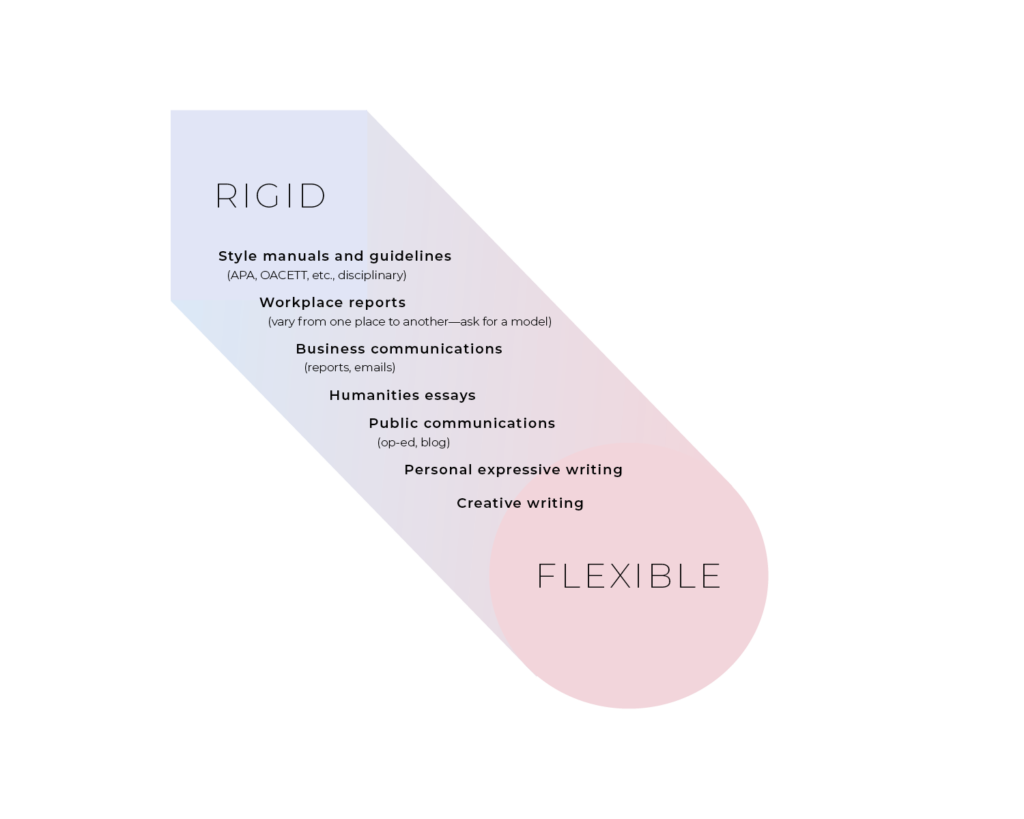12 Be Correct in Context
Philip Loosemore
Correct your work according to context. Provide accurate content and consistent presentation.
What You’ll Learn:
- How to correct things depending on context
- How to protect factual accuracy
We communicate differently in different situations.
What counts as “correct” depends on that situation, and depends on whether we’re speaking or writing, writing a tweet or an essay, presenting at a conference or chatting with a friend.
For instance, in many types of writing, it’s considered incorrect to use:
- Sentence fragments (grammatically incomplete sentences, such as “Arranging the ideas,” or a one-word sentence like “Right.”)
- Contractions (“won’t”)
- Interjections (“yeah,” “oh”)
But in many spoken English contexts, it would be incorrect to avoid these, and a series of grammatically complete sentences would be wrong.
Being correct according to context is an important communication tool.
We’re going to use the word correct in another sense, meaning factually correct. Here, “correctness” is or should be less dependent on context, more absolute or universal. It’s never ok to willingly distort facts, and we must always check facts for mistakes and hold others to the same high standard.
Correctness in Context
When we say “be correct in context,” we mean pay attention to the rules and conventions of the context you’re in.
Dealing with Rules
You can follow the rules. You can break rules, too, but you should always be aware of the possible effects on readers and consequences to you as a writer.
For example, if you’re an engineering technician student in Ontario, Canada, you’ll need to prepare a report according to the rules set by the Ontario Association of Certified Engineering Technicians and Technologists (OACETT).
Here are four of the style and language guidelines for that report:
- The document should be typed, double-spaced using Arial, Univers, or a similar Sans Serif 12-point font.
- The lines should be justified left, with pages numbered and appropriate page breaks.
- Correct spelling, punctuation, and grammar should be used.
- Consistent voice, subject-verb agreement, and verb tenses should be used.
Read the source.
You’re always free to submit a report that is single-spaced, uses serif font, and switches verb tenses frequently. But there are consequences.
Rules in Context: Becoming a “Polyglot”
Items 1 and 2 from the OACETT guidelines above are objective:
- You can measure whether a document is typed and double-spaced using sans serif 12-point font, left justification, and numbered pages.
- The size of 12-point font is standardized and is unlikely to change from one place to another, or to change over time.
- Any two or more people will be able to reach unanimous agreement on whether a given document follows those first two guidelines.
Items 3 and 4 are less objective because the rules of orthography (spelling, punctuation) and grammar do change from place to place, and over time.
There are so many types of written and spoken English, and so many kinds of English speaker and English language learner, that it’s probably better to be able to adapt to many contexts and learn the conventions of different contexts than to “learn the rules,” as if there’s only one set.
Like a programmer who knows many computer programming languages and can pull out the right one for the job, you should become familiar with many different kinds of English (and other languages, if possible) and learn how to adapt to the situation you’re in.

There is no one “standard” or “correct” English.
Correctness and Power
It’s important not to privilege one rhetoric, or form of language, over another.
For example, the English classroom in a North American postsecondary institution can easily feel like a place of judgment, where you sense you’re either “correct” or “incorrect” in your use of language.
But if you’re a student in that setting, remember that the conventions and rules taught there don’t replace other rhetorics you possess and shouldn’t be privileged over them, such as the way you speak and write with friends.
Academic and so-called “mainstream” English are only correct in certain contexts. In other contexts, their rules don’t apply and are sometimes incorrect.
Linguistic Accuracy

Finding Out the Rules
To “follow the rules” of grammar and usage in a particular context, you should look at relevant and reputable examples of the genre, and at relevant style guides.
For example, if you’re learning how to write journalism, read a lot of journalism from around the world, especially from your region and in the specific genres you’re interested in.
In many North American postsecondary institutions, when writing academic essays, you can follow the guidelines for style, layout, grammar, and more set out in one of these manuals:
- APA https://apastyle.apa.org/products/publication-manual-7th-edition/
- MLA https://style.mla.org/works-cited-a-quick-guide/
- Chicago Manual of Style https://www.chicagomanualofstyle.org/home.html
There are also popular, classic texts on grammar and style you can consult:
- Strunk and White’s Elements of Style
- Messenger’s Canadian Writer’s Handbook
If you are writing for a particular publication, you can ask if they have a house style manual.
Flexibility
In some writing situations, there’s a lot of room to experiment, bend rules, or blend rules from different contexts. In others, the rules are more rigid. You can still always bend or break rules, but the stakes and consequences change.
If you’re asked to prepare a paper according to APA style, then there are specific rules of grammar, layout, citation, and more.
If you’re writing a personal blog, social media post, or piece of creative writing, there are conventions and reader expectations, but you can theoretically do anything you want.

Factual Accuracy
We’ve looked at linguistic correctness and said that guidelines depend on context.
We’re going to look at another form of correctness—factual accuracy—and lay down a more universal principle.
Especially in the era of fake news, mass mobile communications, and information overwhelm, it’s more important than ever to uphold the standards of factual accuracy and to be able to distinguish between fact and opinion.
Is It Fact or Opinion?
A fact is a piece of information that can be proven with evidence. It may be accurate or inaccurate.
An opinion is a judgment shaped by personal beliefs, values, and assumptions. It may be informed or uninformed.
An informed opinion is generally an interpretation of available facts, whereas an uninformed opinion may be based on nothing but personal feeling or even prejudices.
See this source for further information.
For example, the following is a fact:
In 2016, 2% fewer Canadian postsecondary students than in 2013 felt their mental health was very good or excellent.
This happens to be an inaccurate fact. The accurate fact is the following (notice the correction of the statistic):
In 2016, 8% fewer Canadian postsecondary students than in 2013 felt their mental health was very good or excellent.
You can see how easy it is to intentionally or unintentionally distort a fact. The consequences can be significant. Two percent and 8% may seem close, but in statistical terms they are very different. The consequences of getting the fact wrong is serious.
Put simply: Facts matter.
Is the following fact or opinion?
Student mental health is worsening.
It’s an opinion, not a fact. It’s a judgment based on
- the statistical data (the fact of fewer students reporting good mental health); and on
- assumptions about how to interpret that data.
Just because the opinion is fact-based does not necessarily make it true or valid.
As this source points out, the statistical decline in students reporting good mental health may not mean that more students are suffering. It may mean that more students are willing to admit to having poor mental health or that more students are able to recognize and label it—in short that there’s more space for expressing mental health problems (Chiose, 2016).
We don’t know for a fact what’s at the root of the decline.
Here, then, is an alternative opinion—that is, an alternative interpretation of the facts:
Students are increasingly able to recognize signs of mental health problems and increasingly willing to admit when they are suffering.
One of these statements may eventually become a fact, if enough convincing evidence can prove it beyond a doubt.
Be a Fact-Checker
Always check your own facts before communicating them. Ensure that you are reproducing data accurately, and also that your sources are reliable.
Likewise, check the facts that others present, or at least check how reliable the sources in question are.
Sometimes you have to go through more than one layer of fact-checking.
For instance, the fact in the previous example, that 8% fewer students reported good mental health in 2016 compared to 2013, comes from a Globe and Mail newspaper article.
The Globe and Mail is a mainstream Canadian newspaper-of-record, meaning that it’s held to a high standard of accuracy and impartiality in its reporting.
That doesn’t mean it never publishes factual errors. But it’s a reputable source, and it publicly corrects errors it makes when these are drawn to the editors’ attention.
In turn, the Globe article was citing a statistic from the National College Health Assessment. So the next step would be to look at that source and determine its credibility.
As of this writing, the web page the Globe article linked to is no longer available. We might not be able to check it directly.
The process, though, remains:
- Check the sources of any facts you cite. How reliable is the given source? Why?
- What sources is that source relying on?
- Remember that methods for collecting data are not always reliable.
- Remember that facts can be distorted, invented, and made to appear credible when they aren’t accurate.
- Remember that all facts can be interpreted in multiple different, sometimes contradictory, ways.
Try it!
Learn how to be correct in various contexts, and learn how to find and apply the rules or guidelines required, rather than memorizing lists of rules.When it comes to factual accuracy, we should be more absolute. Know the difference between fact and opinion. Learn how to vet sources for their accuracy, and always make sure to check your own work for factual accuracy and integrity.

